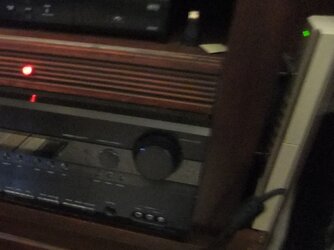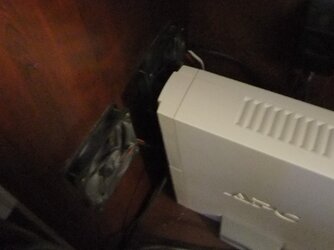Hmm, some news to add: I got me a pair of
Klipsch RB61 II because they was pretty cheap at 500 USD, KEF was 700 USD, so i am at a price of 1200 USD already. Im not gonna add a Elac because simply to expensive and the center speaker need to be good at vocal not at overall sound. So i use a slightly smaller
Wharfedale Diamond 10 CS instead, so the speakers wont be higher than 1500 USD in total but pretty solid 5 channel sound for sure. Only the Wharfedale center missing now, other speakers are ready.
Some questions of course:
1. Usualy they say "dont mix speakers" but even speakers from same manufacturer can have lot of differences and even some of the same series arnt always a good match (i heard many stories already). On top of that, the bass is usualy done either by subwoofer or frontspeakers, other speakers are not going down lower than ~125 Hz because the receiver wont allow. In THX and surround mode there is already some kind of separated work, its not a complete equality. As far as i know surround speakers (in that term im using KEF Q300) dont need to be a perfect match, and on top of that the KEF are masters of "off axis dispersion", a penetration type of speaker so it is perfectly suitable for surround. I got the Klipsch as the new front speakers because of theyr supreme efficiency (they are extremely powerful even at low amp power*) and they are very dynamic in the entire sound range, so they are able to push bass and other specs suitable for frontspeakers, but as a surround they would be inferior. *Im just glad they apparently got a 400 W peak capability, else the crazy efficiency when driven by hard amp could truly kill them when bass is to harsh.
Anyway, I think thats perfect, the only stuff that is a bit of headache is center because they say it should fit to the front speakers, but in a non subwoofer setup they already have to pass regarding bass duty, simply not suitable, there is not much center that would be suitable. Klipsch own series arnt fitting in my mind, i was checking them all, but im not satisfied with the stuff offered, they didnt build a good center speaker. But anyway, the center speaker is usualy used for vocals when watching movies, in usual music environment its pretty much a background speaker and not a main driver. So i think i will try to use a Wharfedale instead. In order to make it suitable i will adjust any of the channel manually and i will adjust as much as possible by hearing... nothing else. I guess im simply gonna try... some speakers may be able to fit, its not a hard rule that "other brands" will never fit, i guess.
2. I finally was able to find the advanced configuration menu for EQ and more, and now the Pioneer is pretty powerful at bass performance, especially with the Klipsch speakers, its crazy stuff. Pioneer may have one of the most advanced setting adjustment and a lot of stuff can be fine tuned, but its very hard to use and lot of stuff simply messed up so it will take incredible work for all the fine tuning but at least its possible. Onkyo never had so much finetuning options, not even nearly... Now that i was making lot of adjustments, the sound is so much better than the one from Onkyo.
But i am not sure how to handle Bi Amp and if that is any use at all? I guess my Pioneer is able to drive 5 channel at Bi Amp?
Finally: Actually lot of stuff im not sure about but i simply trust my ears and feelings. As long as it will fit the budget... all good. There is indeed many good and affordable Hifi stuff but i simply lack the experience and so im a bit unsure how to handle it. If i study to much i will never reach a result, so thats why i was simply "trying out". Ultimately my ears have to say "yes"; no other can take over that duty but some wise knowledge is never wrong.


